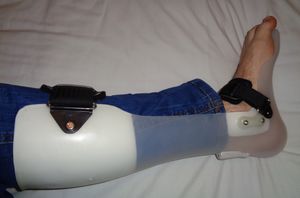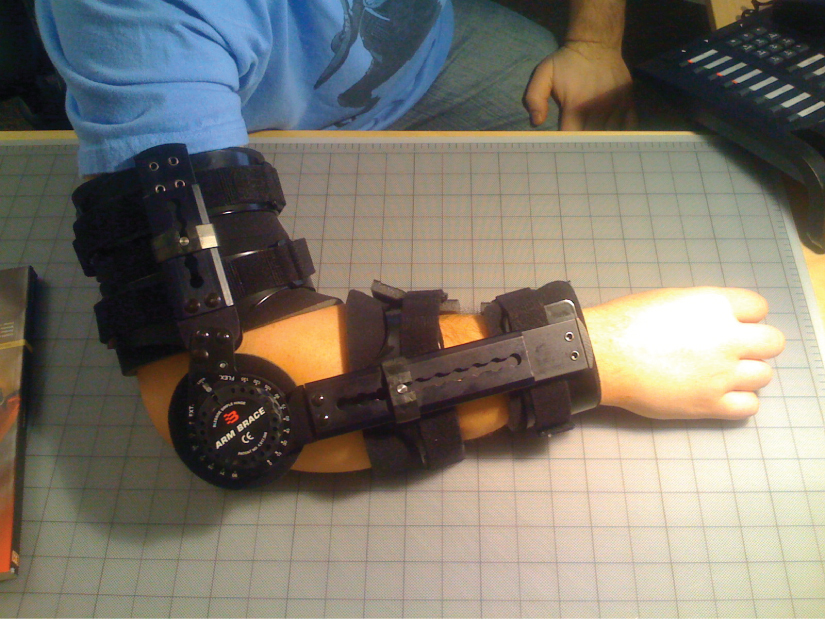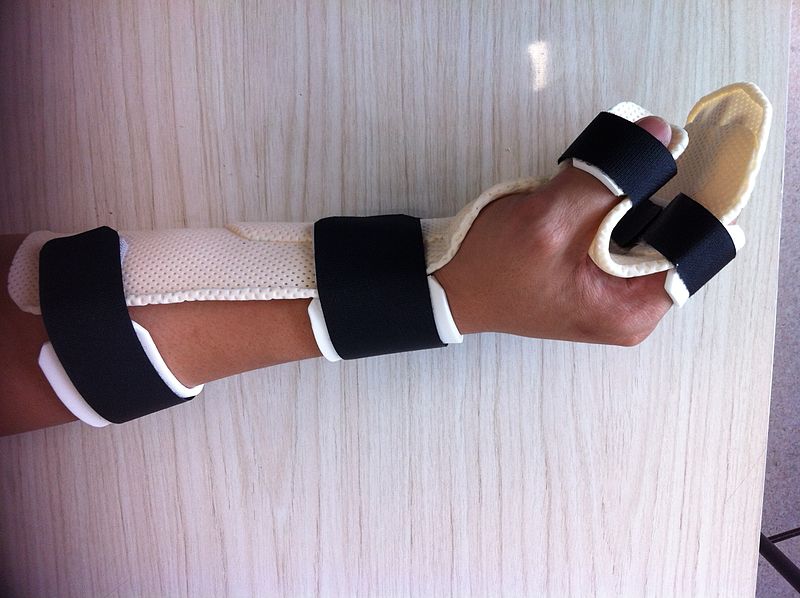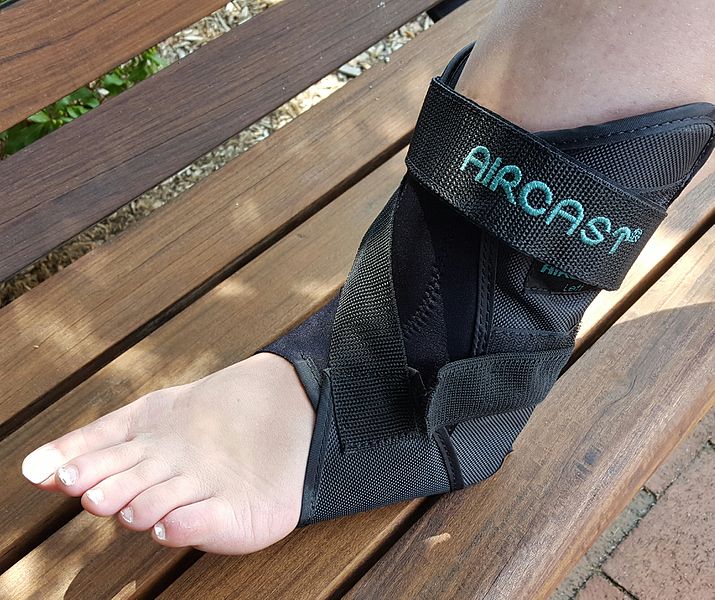Introduction to Orthotics: Difference between revisions
No edit summary |
No edit summary |
||
| Line 74: | Line 74: | ||
* Neuromuscular Electrical stimulation (NMES): | * Neuromuscular Electrical stimulation (NMES): | ||
{{#ev:youtube|qvbMUja6P8Q|width}} | |||
=== Lower Limb: === | === Lower Limb: === | ||
Revision as of 21:54, 27 September 2020
The aim of orthotics are to increase the efficiency of function during acute or long-term injury. This includes soft-tissue and boney injury, as well as changes as a result of neurological changes.
A number of considerations need to be made before deciding on the type of orthotic needed:
- What are the patient’s goals?
- What are the specific impairments impacting on their function (thinking of head to toe or gait analysis).
- Are impairments the result of soft-tissue changes? Can they be changed with therapy input?
- Is a walking aid needed?
- Does the injury need to be protected for particular movements?
- Can an orthotic improve the efficiency of an activity?
- Can the patient cope with any adjuncts given?
Orthotics can be pre-made or customised, depending on the patient's needs.
"Off the shelf" Orthotics[edit | edit source]
Many patient's can utilise ready made orthotics, which can often be adjusted to fit their size.
These may come in small, medium and large sizes but will not need to made alterations made for use by the individual.
Other examples would be a hinge-knee brace, or aircast ankle brace, which can be easily adjusted with velcro straps.
Custom Orthotics[edit | edit source]
Some individuals have more complex injuries / changes to one of multiple joint structures, and therefore require a customised orthosis. This may be particularly true in neurological conditions, such as Cerebral Palsy (CP), Parkinson's Disease (PD) or after brain injury, such as traumatic brain jury (TBI) or stroke. In these cases, spasticity of muscles may have an impact on the patient's function. Orthotics can be used both in resting and during mobility to improve affects of spasticity or reduce risk of contractures. In which case the orthotic will be specifically measured to the individual, and likely to be redone as the individual grows (in paediatrics) or as changes are made to joint structures.
Advantages:[edit | edit source]
Lower limb: Influence both swing and stance phase of gait.
- Prevent or correct deformity and reduce pain during weight bearing
- Improve efficiency of gait and maintain balance
- Improve base of support / lateral support
- Reduce need for compensation of ipsilateral and contralateral limbs and secondary pain
Upper limbs: Can be used after an injury to prevent further injury, or reduced pain by supporting an injured limb.
- Prevent or correct deformity reducing pain and maximising function in reach and grasp tasks.
- In prove efficiency of reach and grasp tasks
- Off load an injured limb to allow healing
- Reduce need for compensation of ipsilateral and contralateral limbs and secondary pain
- Improve role of upper limb in maintaining balance
Spine: Stabalise spinal fractures to allow the patient to return to some normal activies (although they may be restricted) and protect the spinal cord.
Possible complications:[edit | edit source]
- Loss of sensation (check skin regularly- risk of pressure areas)
- Compensations in ipsilateral or contralateral limbs.
- Impact on spasticity (is the patient utilising spasticity to allow some function in absence of muscle strength?)
- Complications of casting at incorrect angle: Foot deformities, increased knee flexion in stance, muscle contractors
- Loss of sensory feedback and proprioception loss
- Ristricted range of motion
- Loss of natural shock absorption and long term joint damage
- Spinal orthotics must be put on and taken off within the guidelines of a spinal professional. Patients may be able to moblise within set restrictions, depending on the severity of their injury.
Also, success depends on patient's acceptance. Consider:
- Cosmesis
- Footwear
- Weight/rigidity
- Ability to Don Doff
- Compensations preferred
- Compensations required
Types of orthotics[edit | edit source]
Upper limb:[edit | edit source]
Healing:[edit | edit source]
- Hinge-elbow brace: May be used to restrict elbow movement post fracture or surgery.
- Slings: Can be used after upper limb injury or surgery to protect the injury site. They can be used to restrict movements in particular directions to prevent further disruption to the injury (for example displacement of a fracture/ fixated bone).
- Splints: Hand or wrist splints are often customised for individuals based on their specific impairment. This often achieved using thermoplastics. These can be both resting and functional.
Functional:[edit | edit source]
- Wrist splint (e.g. fuctural splint)Elbow clasp (tendinopathy)
- Neuromuscular Electrical stimulation (NMES):
Lower Limb:[edit | edit source]
Orthotics can be used to optimise the alignment of the lower limb. This can be used to stabilise a joint to allow it to heal, or to facilitate ease of function. It can also be used to prevent or correct deformity in the lower limb, increasing efficiency.
Healing:[edit | edit source]
- Wedge boot
- Aircast boot
- Hinge-knee brace: Often used to protect knee surgery, such as meniscal repair.
- Splints; Patients with increased tone may require a resting splint to maintain optimal positioning of their lower limb and maintain a functional range in affected joints. Positioning and seated and supine positions are very important for these patients
Functional:[edit | edit source]
- Ankle- Foot Orthosis (AFO): Correct alignment of the lower foot and ankle, which translates to the alignment of the shin, upper leg and pelvis. Can also be used to reduce risk of trips and falls as a result of foot drop.
- Lateral support ankle brace: In patient's after ankle injuries, particularly to lateral ligaments, or neuromuscular disorders, a lateral ankle support may be needed. This brace has stiff lateral supports which will prevent excessive pronation or supination at the foot. This reduces the risk of further injury to lower limb structures, or injuries secondary to a fall.
- Functional Electrical Stimulation (FES): In patient's with central nervous system disorders / leisions, it may be possible to use FES as a dynamic orthosis. Can be used on a number of muscle groups to simulate electrical impulses in peripheral nerves. It is often used to reduced impact of foot drop or knee hyperextension as a result of muscle weakness. There is also some evidence that it may contribute to strengthening of muscles.
- Foot orthotics: With improved alignment, custom-made orthotics help to improve efficiency and minimize shock absorption through the lower extremity, pelvis and spine. They maintain a neutral foot alignment to maintain optimal foot position through the full gait cycle, reducing energy requirements to maintain balance during weigh-bearing and through weight transfer. Therefore, reducing risk of injury. These corrective devices are placed in an individual’s footwear similar to insoles. They can help to realign the many bones within the foot, and to control excessive mobility or excessive rigidity of these bones and connective tissues, to maintain neurtral foot alignment.Failed load transfer through your feet due to poor alignment can influence many joints above such as your knees, hips, pelvis, low back and spine. Custom orthotics are specifically designed to correct foot issues and improve alignment all the way up the lower limb and even through the spine. A trained health practitioner will complete a detailed assessment of an individual’s gait and foot position in both a static and a dynamic state. The health professional will be looking for asymmetries and abnormalities in the feet and lower extremity. This information will be combined with a precise imprint of the feet on a foam cast. This will be sent off to a lab where the orthotics will be fabricated and created. Some facilities will also use a gait scan machine in order to analyse where the majority of your weight is dispersed while you heel strike and push off during the gait cycle. The foot specialist may request that the lab add special features to the orthotics based on the patient’s area of pain, the wear patterns in the patient’s shoes and the skin changes on their feet. The orthotics can be made to fit into your running shoes, dress shoes, flats, high heels or a combination of different shoes.
Consideration: It seems logical to think that pain in the foot region links directly to dysfunction in the foot region and that orthotics are the intervention of choice. Unfortunately, it is not always that straightforward. For example, could hip weakness or lower back pain be causing disruption to the gait cycle and compensatory strategies that place increased load on foot stuctures? It is important to determine what is “driving” the pain in the foot and to direct treatment to these structures to see if insoles are needed. Also, can the intrinsic muscle of the foot be trained either alongside, or instead of the use of insole orthotics?
Any of the following conditions as long as the feet have been shown to be the “driver” of the pain syndrome:
• Metatarsalgia or other foot pain
• Plantar fasciitis [[]]
• Morton’s Neuroma
• Flat feet
• High arches
• Knee pain
• Hip pain
• Low back pain
• SIJ dysfunction
• Degenerative Disc Disease
• Scoliosis
• Osteoarthritis in the knees, hips, pelvis or low back
• Patellofemoral pain syndrome
• Femoral acetabular impingment
• Iliotibial band friction syndrome
• Bursitis in the ankle, knee or hip
• Chronic ankle sprains
• Piriformis syndrome
• Achilles tendonopathy
• Patellar tendonopathy
• Snapping Psoas
• Gluteal tendonopathy
• Hamstring tendonopathy
• Recurrent Calf Strains
• And More...
Spine Orthotics
Uses:
References:[edit | edit source]
1. The Orthotic Group. Orthotic FAQ. Available from: http://www.theorthoticgroup.com/patientsite/OrthoticFAQ.aspx [last accessed 10/12/14]
2. SBI Orthotic Laboratory. Orthotic FAQ. Available from: http://www.sbiorthoticlab.ca/faq_orthotic.html [last accessed 10/13/14].
3. Rebalance Sports Medicine. Custom Orthotics. Available from: http://www.rebalancetoronto.com/sports-medicine-services/orthotics-downtown-toronto/ [last accessed 10/13/14].
4. Roger, Collier. Orthotics work in mysterious ways. CMAJ-Canadian Medical Association Journal. March 8, 2011. Volume 183:p 416-417.










